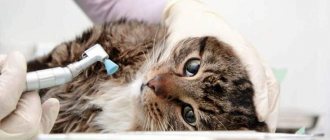Infectious anemia or feline hemobartonellosis (Haemobartonellosis) is one of the infectious diseases that is difficult to diagnose and difficult to treat. The causative agent of the disease is the rickettsia Haemobartonella felis. This intracellular parasite quickly dies outside the body of a warm-blooded animal, and having penetrated its blood cells, it may not manifest itself for a long time. According to veterinary statistics, severe symptoms of the disease are observed in only 25% of animals carrying the infection.
Routes of infection
Infection can enter a cat's body in various ways:
- She may be bitten by another cat that is a carrier of hemobartonosis.
- The infection often enters the bloodstream through scratches or more serious injuries. That is why male animals are more susceptible to the disease: cats are known fighters, cats prefer to stay away. However, you should not think that this disease does not threaten your cat: both can become infected.
- Hemobartonellosis is transmitted by ticks and fleas, which are especially active in the warm season. In some cases, newborn kittens become infected. If the mother is a carrier of the disease and the owner does not know about this problem, after giving birth to offspring, the cat infects her babies.
Reasons for the development of pathology
Hemobartonellosis is a pathology that develops as a result of infection of a cat with the rickettsia Haemobartonella felis (hemobartonella), which lives on the membrane of red blood cells and leads to disorders of the hematopoietic process in the body.
The disease is transmitted:
- with bites of insects that feed on blood - fleas, ticks;
- when the skin and mucous membranes are damaged by rodents that are carriers of the disease - rats and mice;
- with direct blood transfusion of an infected animal;
- in utero - from a sick cat to kittens.
Once in the cat’s body, the microorganism temporarily “falls asleep”, becoming more active during a sharp decrease in immunity due to vaccinations, infectious diseases, pregnancy, operations, and stress.
Young animals, cats with immunodeficiency and kittens are most susceptible to infection.
For your information. Feline hemobartonellosis occurs only in felines and does not pose a danger to other animals or people.
Symptoms of the disease
Characteristic symptoms of hemobartonosis may appear some time after infection. The incubation period of the disease lasts from one to two weeks. During this time, the infected cat sharply loses weight, shows less and less physical activity, becomes lethargic and indifferent to everything.
Such symptoms are inherent in various ailments of our furry pets, so it is worth paying attention to others.
Take a closer look at your cat's breathing. It is usually not easy to notice, even when it is hot. If an animal is sick, it breathes quickly, which is not typical for a cat. After checking your pet's pulse, you will probably feel that it is quickened. If shortly before this the cat was bitten by fleas or ticks, or was injured, it can be said with a high degree of probability that she has hemobartonosis.
Not all animals develop the disease with pronounced symptoms. You may simply not notice some signs of the disease. But that doesn't mean it doesn't exist. If you notice some deviations in the animal’s behavior, you should immediately show it to a veterinarian.
Prevention of infectious anemia in cats
As you know, any disease is easier to prevent than to treat. There is currently no vaccine for hemobartonellosis.
The simplest and most effective preventive measure is to limit your pet’s contact with stray animals.
The following rules should also be observed:
- Domestic cats are much less likely to get hemobartonellosis, so it is better not to let them outside.
- If you buy a kitten from a cattery, make sure that its parents are healthy and vaccinated.
- Strengthen your cat's immunity, remember that a weak immune system is a real gift for infections and viruses.
- Watch the feeding, it should be balanced in vitamins and microelements.
- Do not limit your cat's physical activity, allow it to play and move.
- Do not neglect the harness while walking, this way you will be sure that the cat has not come into contact with possible carriers of hemobartonellosis.
- Use anti-flea and anthelmintic agents to create a barrier for parasites, use collars, special anti-repellent agents in the form of shampoos, drops, and powder.
- Observe hygiene standards for keeping your pet.
- Systematically treat the premises against fleas using disinfectants.
If your pet does get sick, take good care of him and speak kindly, as cats react very sensitively to the psycho-emotional situation in the house.
Diagnostics
If you think your cat is sick, you don’t need to treat it yourself. As soon as possible, take the animal to a veterinary clinic. Experienced specialists will be much more likely to make an accurate diagnosis than you or your neighbor.
The veterinarian will examine your pet, do all the necessary tests, talk with you, and only after that will he be able to determine whether the cat is sick or not.
Some symptoms can be determined by eye - for example, pallor of the oral mucosa, dull, tousled fur, and a vacant look indicate tissue hypoxia. A sick animal stops responding to its name, clicks, and loud sounds. There are other signs by which the doctor will accurately determine what has happened to your cat.
An experienced veterinarian will send your cat for a blood test. A blood smear can tell much more about your pet's health than the other symptoms combined. There is no need to give up analysis. An accurate diagnosis will help prescribe the correct treatment, and your pet will be able to recover faster and return to a full life.
But it also happens that the animal shows obvious signs of illness, but you cannot get an appointment with a veterinarian. Well, in this case you will have to help the pet on your own. Calm down, collect your thoughts and start acting.
Diagnosis of feline hemobartonosis
If hemobartenellosis is suspected in cats, treatment is preceded by mandatory diagnosis. The diagnosis is made on the basis of epizootic, clinical data, as well as mandatory hematological testing (for the presence of the pathogen in the blood). Diagnosis of hemobartenellosis comes down to identifying the parasite in the erythrocytes of sick animals by microscopy of blood smears. Detection of hemobartonella in erythrocytes is not an easy task; a negative result is not 100% reliable. A series of studies is always carried out; parasites are detected in the blood of only 25% of infected animals.
In addition to examining smears, polymerase chain reaction (PCR diagnostics of hemobartonellosis) and the direct Coombs test are also used.
A general clinical blood test in sick cats reveals regenerative anemia (if autoimmune suppression of the hematopoietic function of the red bone marrow has not started), and a biochemical study reveals bilirubinuria and bilirubinemia.
How to determine hemobartonellosis in a cat yourself
First of all, carefully examine the cat. What does her skin, mucous membranes, and fur look like? With oxygen starvation, yellowing of the skin is observed. Sometimes they can take on an orange tint. The skin becomes denser and harder to the touch. It will not be difficult for the owner to check this.
Then you need to conduct a thorough examination of the skin. Do not ignore the inside of the ears, nose, and paw pads. If you notice even a minor damage - a wound, a scratch, a characteristic bite mark - take a closer look to see if they are inflamed or festering?
Try to examine your gums. With hemobartonellosis they will be pale and yellowish in color. Take your cat's temperature. If it is very elevated, the animal has another disease. Hemobartonellosis is characterized by normal or slightly elevated temperature, especially when the disease has become chronic.
Remember if the cat’s voice has changed in timbre. With hemobartonellosis, he may become hoarse. If all these symptoms are present, it means your pet has bartonellosis.
Similar and concomitant diseases
Some disorders may be similar to the symptoms of bartonellosis bacteria:
- Adenitis is an inflammatory disease characterized by lymphadenopathy; adenitis can include all types including: bacterial, fungal and tuberculous adenitis.
- Brucellosis is an infection of livestock that can be transmitted to humans. It is caused by various types of Brucella bacteria. The initial infection may lead to an acute influenza-like illness or may develop over several months. Lack of adequate treatment leads to a chronic stage. Symptoms may include an initial stage of fever, weakness, headache, joint pain and night sweats.
- Lymphogranuloma venereum is a sexually transmitted infection characterized by primary skin lesions at the site of infection, usually the genitals. Lymphadenopathy appears on one or both sides.
- Lymphomas are growths of lymphoid tissue. These tumors are divided into two types: Hodgkin's and non-Hodgkin's lymphoma. Hodgkin's lymphoma is a cancerous form of lymphoma; symptoms will depend on the type and location of the tumor. Symptoms may include lymphadenopathy, hoarseness, high-pitched respiratory sounds when inhaling, and difficulty swallowing.
- Kaposi's sarcoma is a cancerous tumor that often appears as a bluish-red or purple bump on the skin and is often associated with AIDS.
- Pyogenic granulomas are small reddish bumps on the skin, the exact cause of which is unknown, but often appears on the hands or face.
- Hemangioma is a benign tumor made up of blood vessels that usually appears as a purple or reddish, slightly raised area of skin.
- Lyme disease is a tick-borne infection. The most common initial symptom is an expanding, flat or slightly raised red patch of skin lesion that develops at the site of the tick bite. Flu-like symptoms may develop within days or weeks of infection. Later manifestations may include arthritis, central nervous system disorders, or heart failure.
This is interesting: Bloom's syndrome - photos, symptoms, treatment methods
Is feline hemobartonellosis dangerous for humans?
Having heard from a veterinarian that everyone’s favorite animal has been diagnosed with an infectious disease, the owner quite naturally wants to know how contagious it is, and whether he and his family members, as well as other animals living in the house, could be harmed. In the case of hemobartonellosis, we can confidently say: this disease does not pose any danger to humans and other animals (except cats). Remember the other name for hemobartonellosis: feline infectious anemia. This means that neither dogs, nor canaries, nor guinea pigs are in danger. You can look after your four-legged friend without any worries. But, of course, hygiene rules must be strictly observed.
What to consider when choosing a medicine
Regardless of whether your cat will undergo treatment at a veterinary clinic or you will treat it at home, when choosing a medicine, you must adhere to the following rules:
- choose a drug that has a comprehensive effect on pathogenic microflora; try to choose a medicine whose introduction into the body would cause the animal as little suffering as possible;
- the drug, along with its positive effect, should not cause harm to the body weakened by the disease;
- it is desirable that the medicine acts exclusively on pathogenic bacteria; When choosing a drug, pay attention to ensuring that it has as few side effects as possible.
Mechanism of development and routes of infection
Experts agree that Bartonella occupies an intermediate position between rickettsia and bacteria. It is a microscopic intracellular parasite that prefers to settle on red blood cells. When it enters the blood of an animal, Bartonella attaches to red blood cells and immediately begins to actively multiply. This provokes the destruction of red blood cells, the lack of which in the blood causes anemia in the pet. It should be understood that in some cases the pathology is asymptomatic, since the production of red blood cells may exceed their destruction.
Hemobartonellosis in cats can move from a latent stage to an active form, under the influence of such reasons as:
- significant disturbances in the functioning of the pet’s immune system, vitamin deficiency;
- the appearance in the cat’s body of “background” infections or diseases caused by the activity of parasites;
- oncological diseases;
- pregnancy;
- sterilization or castration of an infected pet;
- birth process.
Each of the above reasons can lead to the fact that hemobartonellosis will be complicated and begin to express itself in a more severe form.
There are many ways for infection to enter the blood. This can occur due to a bite or scratch from an infected tribemate. That is why males are in a special risk zone, since they are by nature more pugnacious. Another common cause is bites from blood-sucking parasites, in particular fleas and ticks.
No less rarely, feline hemobartonellosis is inherited from parents to kittens. However, doctors find it difficult to give an exact answer as to exactly which route: either with mother’s milk, or through the placenta, or during the passage of the fetus through the genital tract. Statistics have shown that the disease most often affects young individuals under the age of 2.5-3 years.
Treatment "Unidox Solutab"
If a sick cat eats little by little and has not previously refused to take tablets, it can be treated with Unidox Solutab.
The drug is prescribed at a dose of 5-10 mg per kilogram of animal weight. It is placed directly into the mouth once a day, feeding the entire dose at once.
The pharmacy may offer you an analogue of Unidoxsolutab called Doxycycline. Unlike the first drug, which is produced in the form of a suspension or tablets, Doxycycline goes on sale in the form of capsules.
How are these drugs different?
First of all, because “Unidoxsolutab” does not cause side effects characteristic of “Doxycycline” and expressed in severe effects on the gastrointestinal tract. "Unidoxsolutab" can be dissolved in a small amount of water and mixed with cat wet food, or you can put it in your mouth whole. It will act the same. The advantages of Doxycycline include its significantly lower cost: it is almost twenty times cheaper than Unidoxsolutab.
Treatment with Azidine
The most effective way to treat hemobartonellosis in cats is the administration of Azidine. The optimal dosage of this drug is 5 mg per kilogram. Smaller dosages of the drug (3.5 mg per kg) also have an effect, but only the signs of the disease disappear, and the pathogen itself remains in the blood. When large dosages of the drug are administered, the following side effects may occur:
- excitability increases;
- Blood pressure may drop slightly;
- intestinal motility is disrupted.
These symptoms disappear two days after the injection. In this regard, self-medication with Azidine is undesirable. It is advisable to consult an experienced veterinarian before using this drug.
Treatment of hemobartenellosis in cats
The scheme for successful treatment of hemobartenellosis in domestic cats depends on the qualifications of the doctor and the degree of damage to the internal organs of the animal. Based on the data obtained, the specialist develops treatment.
Therapy for infectious anemia is quite long and in the normal course lasts up to 3 weeks. In complex, severe cases with serious damage to internal systems, treatment may be delayed. The basis of therapy is the destruction of parasites and elimination of associated symptoms.
The following medications are widely used:
- antimicrobial agents (Tetracycline, Doxycyline, Oxytetracycline);
- iron supplements - to eliminate the symptoms of anemia, increasing the number of red blood cells in the blood;
- drugs that stimulate the process of hematopoiesis (hematopoiesis stimulants) Coamide,
- vitamin complexes (vitamin B12, B6, vitamin E and riboflavin);
- antihistamines (in severe cases of infectious anemia);
- blood transfusion - in severe cases of illness and blood purification.
During treatment for hemobartenellosis, the drug Baytril has a good therapeutic effect. It not only has antimicrobial properties, but also helps increase the body's defenses. The general strengthening of the body's immune forces increases the chances of a complete recovery of the animal.
"Baytril" for hemobartonellosis in cats
One of the popular drugs used in the treatment of hemobartonellosis is Baytril. It has a complex effect not only on the causative agent of this disease, but also on other infections. This contributes to a significant improvement in the overall health of the cat.
The drug is administered by injection. This is much more convenient and simpler than trying to give a pill to an animal that refuses food due to poor health. In addition, many cats immediately turn away from the bowl as soon as they smell a suspicious odor.
The medicine lasts a long time. You don't have to give your cat injections often; one injection is enough for a day. Accumulating in areas affected by the disease, the drug affects mainly them. Baytril almost never causes allergic reactions.
If the dosage is followed as prescribed by the veterinarian, the cat tolerates the drug normally.
Attention breeders! After treatment with Baytril, male cats can reproduce. The medicine will not affect their reproductive function in any way and will not harm future offspring.
The use of Baytril is completely safe for your pet’s immunity.
And one more important fact: the medicine does not deteriorate for about a month after opening the bottle. If someone you know needs it, you can always share it within this period. Usually the drug is administered into the animal’s body for five days in a row, but if the case is too advanced, the doctor may extend the course of treatment. The dosage is also prescribed by the veterinarian.
Pathogenesis of feline hemobartenellosis
Widespread microbial carriage is expected among clinically healthy animals. After a healthy cat is infected with hemobartheneliasis, the animal can become a chronic carrier without pronounced clinical symptoms or become ill in an acute form, with severe anemia, often leading to the death of the cat.
The incubation period can last from 8 to 15 days. During this time, pathogens multiply both on the surface of red blood cells and inside them. The number of healthy red blood cells decreases, and the level of hemoglobin decreases. In parallel with this, jaundice and hemoglobinuria appear. The animal becomes lethargic, quickly gets tired, and its appetite decreases or disappears completely. The cat is noticeably losing weight.
Anemia in hemobarthenelosis can be caused either by direct damage to the red blood cell membrane by parasites, followed by their lysis in the spleen and liver, or by immune-mediated intravascular hemolysis caused by the cat’s body producing antibodies to its own red blood cells, followed by their destruction by the complement system.
Often the latent form of hemobarthenelosis is activated by systemic pathologies that affect hematopoiesis (the formation of blood cells in the red bone marrow). Such pathologies include chronic kidney disease, systemic inflammatory reactions, viral infections, etc. The presence of this group of diseases greatly aggravates the clinical course of hemobartenellosis by the absence of a regenerative response of the red bone marrow to anemia; anemia acquires a regenerative nature (increased formation of red blood cells does not occur in response to a sharp decrease in the number of mature forms), which significantly worsens the prognosis of the animal and sharply increases mortality.
Prevention
How to protect your cat from infection? How to avoid infecting your favorite furry creature? It's not easy, but it's possible.
Since hemobartonellosis is transmitted through contact with an infected animal, it is necessary to isolate the domestic cat from communication with free relatives. Pedigree cats that are not allowed to leave the house cannot become infected.
It is very important to strengthen the immunity of pets. Cats are not as sissy as they might seem. And if the infection has found access to their body, this means that the immune system is greatly weakened due to poor care and improper nutrition. What does that require? High-quality food, veterinary examination, calm atmosphere in the house. Keep the dishes your cat eats and drinks from clean. Keep her sleeping area and litter tray perfectly clean. Do not leave home unaccompanied. Put a harness and leash on her and go for a walk together. Every day and be sure to inspect the coat after a walk. This way you won’t miss a tick or the quickest flea. Particular vigilance must be exercised when breeding purebred animals. They require regular veterinary examination. This applies to both cats and cats.
A cat cannot complain about feeling unwell. She will try to avoid people, begin to hide, and seek solitude. Therefore, a loving owner needs to show maximum attention in order to recognize a lurking illness in time and help the defenseless animal. Find at least a few minutes a day to chat with your pet, pay attention to any deviation from the norm in its behavior - and you will be able to “catch” the disease at the very beginning. Your cat has every chance of recovery!











